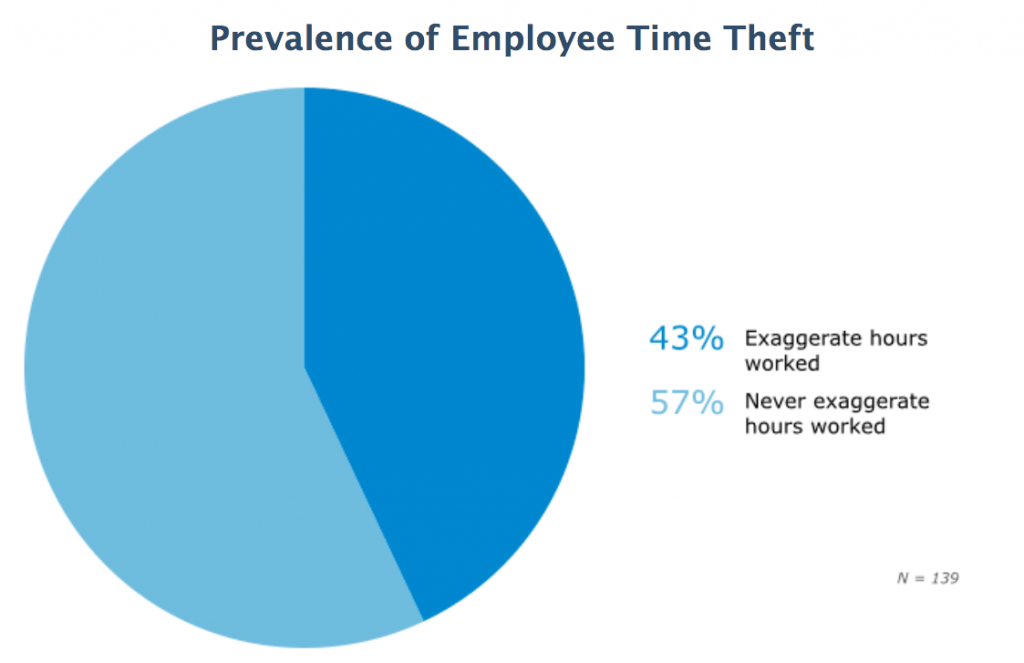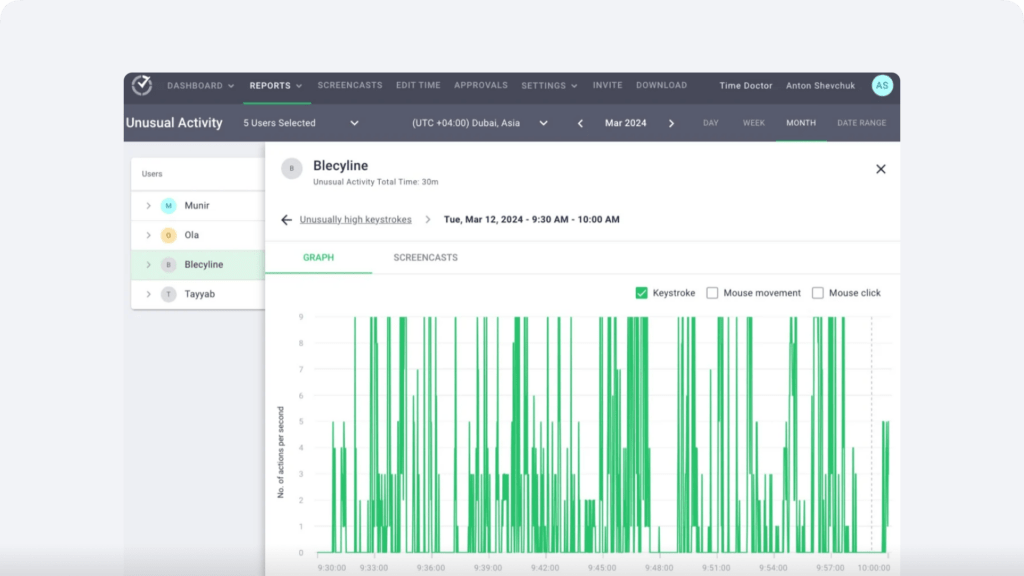Whether it’s extended breaks, taking excessive personal timeouts, or using technology for non-work purposes, time thefts can prove to be expensive for your business.
An accountant in Canada was ordered to repay their former employer CAD 2600 for time theft tracked while working remotely in 2023.
Check out these time-theft statistics to understand how even a few minutes can put a dent in your bottom-line.
- According to the American Society of Employers, 20 percent of every dollar earned is lost to employee time theft in the U.S.
- Robert Half International’s study revealed that an average employee steals about 4.5 hours each week from their employer. This amounts to six full work weeks annually, costing businesses billions.
Thus, time theft can seriously ruin your business profits. This detailed guide aims at covering the following sections:
Table of Contents
What is time theft?
Time theft occurs when employees accept pay for the time they haven’t worked. Time theft doesn’t always have to be deliberate and malicious. It can also happen by accident or due to negligence.
Time theft can result from activities as menial as arriving late or leaving early. It may even result from your employees’ malicious actions, such as deliberately running errands during work hours.
Time theft can lead to losses in time and money for companies. The time and money lost due to time theft can significantly hinder the progress of your company. And thus, time theft is not something that should be ignored or taken lightly.
Every minute of time theft counts, and you should actively take steps to reduce your company’s occurrence of time theft.
Eye-opening statistics on how time theft can impact your business profits
Are you still confused about why time theft should be a big deal and why should you direct your resources towards curbing it? Then here are some eye-opening statistics on time theft:
- Time theft causes U.S. employers more than $400 billion per year lost in productivity.
- In a survey done in 2015, 43% of employees admitted to deliberately committing time theft. And, 25% of employees admitted to reporting more hours than they actually worked 75% to 100% of the time!
- A survey on accountants revealed that more than 92% of their clients experienced a time theft problem.
- In the United States, the practice of buddy punching costs employers $373 million in a year.

How employees steal time or what is considered as time theft?
Now you know how prevalent time theft is and how much of a significant impact it can have on your company’s growth. If you are wondering what exactly is considered as time theft, then here’s a list explaining just that:
1. Extended breaks
Having extended lunch breaks is one of the most common factors that contribute to time theft. It is easy to lose track of time during lunch and coffee breaks.
Suppose your employees leave for their break 5 mins early, and they come back 5 mins late for three breaks in a day. This contributes to a time theft of 30 mins per employee per day.
This might not seem much. But when compounded over time, this will come up to 2.5 hours of work time per employee per week, and more than 10 hours of work time lost in a month.
2. Buddy punching
Buddy punching is when an employee asks other employees to punch in for them. This means your employees are coming in late or ghosting, but this lost time is not accounted for officially.
Buddy punching or ghosting, again, is a common form of employee time theft. And, this can result in significant losses for your business’ productivity and resources.
4. Finishing early or arriving late
If you do not have a strict employee schedule to follow or a punching system, this form of time theft might be common at your workplace. Your employees are probably arriving late and leaving early at work while filling in the same amount of time in their timesheets.
5. Unauthorized personal time
Employees also tend to spend excessive time attending to personal tasks and matters, more than you’d guess.
Of course, some personal time is required to be taken during working hours. That is not a problem. The problem occurs when your employees start spending excessive, unauthorized time on personal tasks.
This includes spending excessive time on activities such as attending personal calls, sending personal messages and emails, doing tasks such as paying bills and shopping or managing their business activities during your work hours. This can also lead to a considerable amount of time theft.
6. Extended socializing during work time
Socializing amongst employees and cracking a few jokes here and there is a good thing. Socializing can help your employees be more productive. But the problem arises with excessive socializing.
When employees socialize in groups for extended periods, like 30 mins or even an hour, that contributes to time theft. Socializing in groups is much worse as it contributes to huge time and monetary losses for the company.
7. Unauthorized internet usage
The Internet is one of the most tempting worlds to get lost into. With the whole world of entertainment and social media just a few clicks away on mobile devices, your employees can spend hours browsing the Internet on non-work related things.
Unauthorized or non-work-related internet usage can either happen from personal devices or office laptops and desktops. This can contribute to a significant amount of time theft for your company, and hence it is essential to be looked into.
8. Genuine mistakes
As mentioned above, time theft does not necessarily occur intentionally. Sometimes, your employees may forget to clock in or clock out in your employee tracking system, or there might be some manual discrepancy in the system.
All these mistakes can lead to time unaccounted for and thus contributing to time theft in your company.
9. Misuse of paid leaves
Misusing paid leaves by using it for personal reasons against the company policies also counts as time theft. This includes instances where your employees call in sick and misuse their paid sick leaves for personal recreational reasons.
How time theft impacts business productivity and bottom line

Even smaller chunks of time theft ranging from 10 to 15 minutes here and there contribute to a significant loss of productivity to businesses.
Time theft may seem insignificant. Policing your employees over it and focusing on curbing time theft may seem like a petty and menial task.
You should understand that over time, time theft amongst employees can become normalized to an extent where employees may not feel that stealing work time is unethical and wrong.
The ill-effects of time theft are significantly more when you have a large workforce with multiple employees engaging in time theft, intentionally or unintentionally.
Apart from decreased productivity and increased monetary losses for your company, time theft can also lead to bad customer service resulting in a bad reputation. This happens especially when customer-facing employees contribute to time theft.
Hence, time theft is something that needs your attention.
Strategies you can use to tackle employee time theft effectively
Tackling time theft requires a proactive approach that not only identifies the root causes but also offers practical solutions to mitigate it. Here are some actionable strategies you can implement right away to prevent time theft and enhance employee productivity:
1. Educate employees on time theft and its consequences
Most employees may not fully understand what time theft entails or the significant impact it has on the organization. Start by raising awareness and educating your team on how even small time thefts, like extended breaks or frequent personal tasks, can accumulate into larger losses.
Hold workshops or team meetings where you clearly explain time theft, backed by statistics relevant to your industry. Use tools like Time Doctor to showcase how time is tracked and why accurate reporting benefits everyone, including the employees themselves.
To make your point more effective, you can share stats from other resources. You can also come up with your stats through an approximate estimate on how time theft has been affecting your business growth over the past few years. You should let your employees know how much each hour of time theft costs for your organization.
2. Implement clear policies and set expectations
Having clear, well-documented policies around working hours, breaks, and personal time is essential. Create a detailed time theft policy outlining what is acceptable and what isn’t, and ensure it’s included in the employee handbook.
With Time Doctor’s tracking software, you can ensure transparency as employees understand that their work hours are being accurately recorded. Communicate the consequences of time theft and emphasize that this isn’t about micromanaging but rather fostering a fair and accountable work environment.
3. Utilize employee time tracking software
Manual tracking systems are often unreliable and open to manipulation. Implementing automated time-tracking software like Time Doctor can significantly reduce time theft. Time Doctor tracks not only the hours worked but also the productivity levels, ensuring employees stay focused on work-related tasks.
With features such as real-time tracking, optional screenshots, and detailed reports, you can monitor employee activity throughout the day. This prevents unauthorized breaks, extended socializing, and misuse of work time on non-work-related activities. Plus, the Unusual Activity Report feature flags any discrepancies that may indicate potential time theft, ensuring swift action can be taken.

4. Set realistic expectations and allow flexibility
While monitoring time is crucial, it’s equally important to create a work culture that values flexibility. Setting overly stringent rules may lead to frustration and a drop in employee morale. Instead, allow employees some level of flexibility while setting realistic expectations about work hours.
For instance, having 20-minute lunch breaks might not seem like a reasonable time for your employees. If you add this to your policy, you might end up with many frustrated employees who no longer feel motivated to work. Hence, be careful while setting time theft expectations.
With Time Doctor, you can offer flexible work hours while ensuring accountability. Employees can clock in and out from anywhere, and the software automatically logs their time and activity, making it easy to monitor without making them feel micromanaged.
5. Introduce a performance-based system
Time theft often occurs when employees feel unmotivated or disengaged. A performance-based system where employees are rewarded for completing tasks or meeting goals, rather than simply clocking in, can reduce time theft. By focusing on output rather than just hours, you can foster a culture of productivity.
Using Time Doctor, you can measure productivity based on the time spent on tasks and projects, offering insights into performance. This helps you create a balanced system that encourages results over hours logged, reducing the temptation for employees to waste time.
6. Monitor and review regularly
To effectively tackle time theft, it’s important to continuously monitor and review your strategies. Conduct regular reviews using data provided by your Time Doctor reports to identify patterns of time theft and find areas for improvement.Time Doctor’s detailed analytics can help you identify employees who consistently take long breaks, frequently arrive late, or spend excessive time on non-work-related activities. This allows you to have informed conversations with employees and provide constructive feedback.
Key takeaways
We can summarize this guide by saying that time theft can have significant negative consequences on your company’s growth.
Not only can it contribute to reduced employee productivity and slower growth, but it can also result in a bad reputation for your company.
So, ensure that you start addressing employee time theft starting now. Put up policies and time tracking systems in place. Educate your employees on all your time theft policies and take disciplinary action against those who violate your guidelines. Take help from this comprehensive guide to coping with time theft in your organization. Over time you’ll find an accelerated growth in your company’s productivity.
About The Author:

Gaurav Belani is a senior SEO and content marketing analyst at Growfusely, a content marketing agency that specialises in content and data-driven SEO. With more than seven years of experience in digital marketing, his articles have been featured on popular online publications related to EdTech, Business, Startups, and many more.


